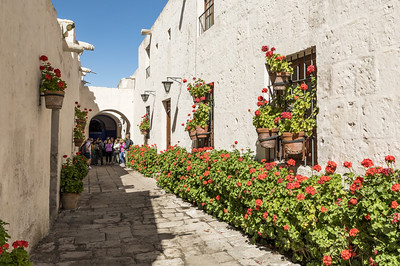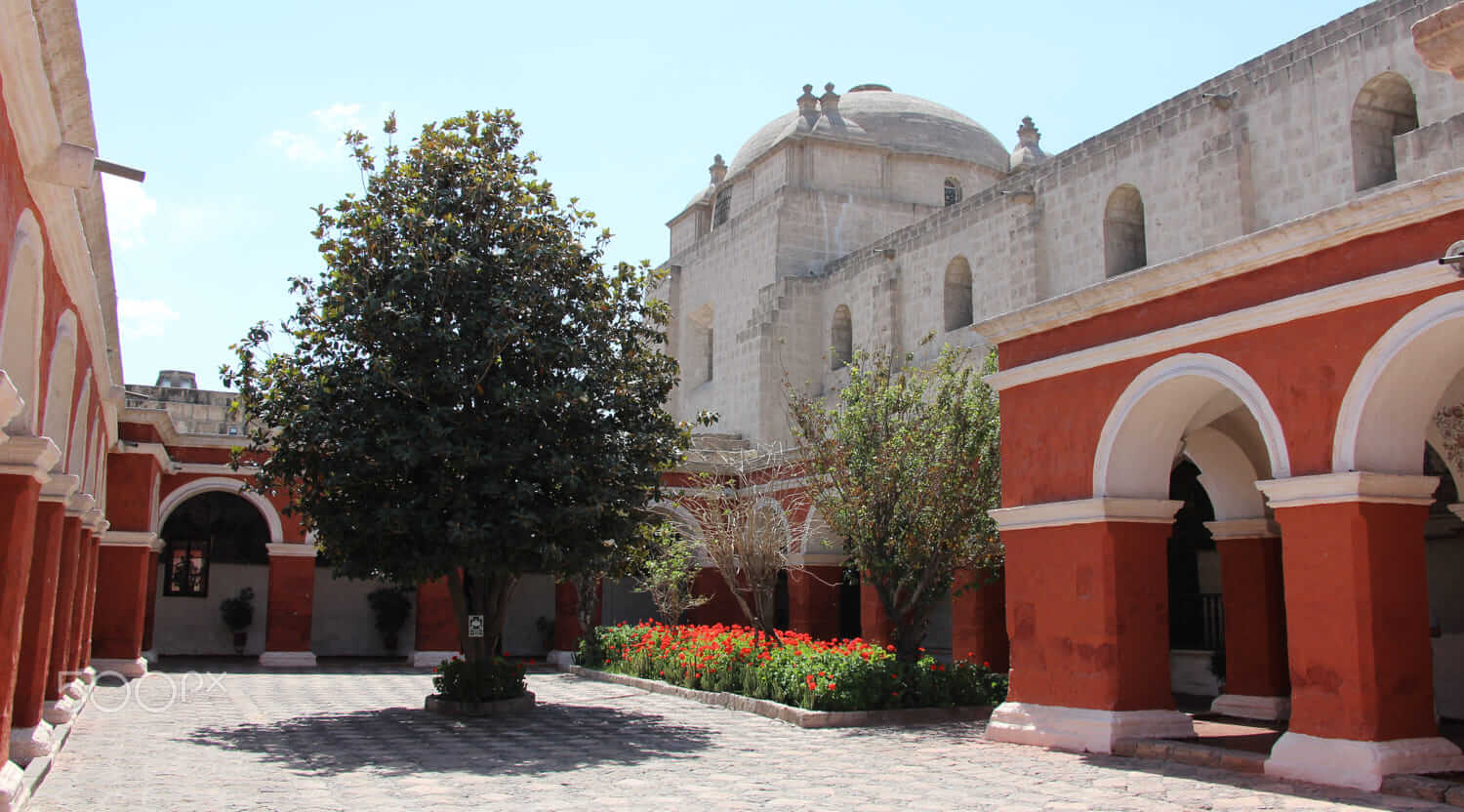The city of Arequipa has a rich history that is reflected in every corner. Among its most representative places is the Santa Catalina Monastery in Arequipa Perú, a place that is characterized by its colonial architecture, which stands out for its construction materials and its picturesque walls of colors such as red, white, blue, among others. To this is added, his surprising stories that relate important events and characters in Peru.
The Santa Catalina Monastery in Arequipa Perú is considered one of the most beautiful temples in America, which keeps the most harmonious architectural expressions typical of the colonial era.
Location
Located in the department of Arequipa, this monastery was founded for a group of nuns on September 10, 1579 in honor of Santa Catalina de Siena. However, it was in 1559 that the efforts to build this convent began. The project was approved by Viceroy Fracisco Toledo and worked under the supervision of Don Juan de la Torre, a knight with the golden spur.
History


In the middle of the 16th century, the king of Peru, Francisco de Toledo, during his visit to the city of Arequipa, received information from the council about the importance of founding a monastery of nuns. From that moment, he made the decision to grant the necessary licenses to begin construction and found the “Private Monastery of Nuns of the Order of Santa Catalina de Siena”.
Later, Doña María Guzmán, widow of Diego Hernández de Mendoza, decides to seclude herself in the monastery that was under construction, and donates all her assets to this place. For this reason, during the capitulation of the foundation of the monastery, in 1579, Doña María de Guzmán was named the first inhabitant and prioress of the monastery.
The Santa Catalina Monastery in Arequipa Perú, for its part, received Creole nuns, mestizos and daughters of curacas and, in 1964, the nuns of Spanish nationality arrived. Likewise, the history of this place indicates that nuns without a dowry entered the monastery, whom they contemptuously called “poor nuns” and the ladies of the city. This last group of women did not indulge in religious life, but stayed in the monastery to exercise their virtues.
In 1582, during the earthquake that struck Arequipa, the monastery suffered several damage to its facilities. For this reason, the nuns themselves had to repair their rooms.
The architecture of the Santa Catalina Monastery
Without a doubt, the Santa Catalina Monastery in Arequipa Perú draws the attention of tourists for its beautiful and historic architecture. Its constructions are made of porous volcanic lava stones, known as ashlar and mud. Also, these colorful buildings have unique architectural forms and fine details that capture the attention of visitors.
The Santa Catalina Monastery in Arequipa Perú is a small citadel that occupies an area of 20 thousand square meters. This is divided into four neighborhoods, which emulate the Arequipa urban distribution of the first years of the colonial era. Similarly, its architectural style combines Spanish and indigenous influence. But, due to the earthquakes that have affected the city on several occasions, the first buildings of the monastery deteriorated. For this reason, it had to be remodeled and some parts had to be modified. However, they sought to preserve part of its initial architecture.
The outer part of the Santa Catalina Monastery in Arequipa Perú is protected by a thick high wall. Its interior is like a labyrinth, formed by narrow streets and passageways with Spanish names such as Seville, Granada, Malaga, Toledo, among others, which converge in a small square in the center of the temple.
This small citadel has rooms that were designed with different dimensions and comforts according to the social origin of the nuns. In the place, you can also find small enclosures for various types of workshops such as crafts or cooking. Currently, the Santa Catalina Convent is a tourist center to which Peruvian and foreign visitors come eager to visit it and learn more about its history.
In addition, this charming destination has large areas, rooms, corridors, streets and gardens. Added to this is a large amount of religious art such as paintings and sculptures, which make this a perfect place to learn about the history of the monastery in depth.
If you are interested in visiting the Santa Catalina Monastery in Arequipa Perú, you can visit its main places such as the Front of the Monastery, the Cloister los Naranjos, the Patio el Silencio, the Main Cloister, the kitchen, the laundry, the Bell Tower and the church.
Inside, you will also have the possibility to visit its museum, which houses great works of religious art from America and the Cuzqueña School. This place that opened its doors for the first time on August 15, 1970, has guided tours, which will allow you to know in depth the religious history of this monastery.
How to get to the Santa Catalina Monastery?
If you leave Lima you can take a direct bus to the city of Arequipa, where the Santa Catalina monastery is located. Some of the companies that provide you with this service are: Oltursa and Tepsa. Once in Arequipa, you should get to the Plaza de Armas, and go down to the avenue that is located next to the Basilica.
In the same way, you can take advantage of your visit to know more tourist destinations. Among them is the Plaza de Armas, in which important buildings such as its three portals and its church stand out. In addition, you will find its attractive pool and a charming view of the landscapes that surround it.
Other destinations in the ‘White City’ that you cannot miss are: the Colca valley, Sangalle, the Arequipa cathedral, the Yanahuara viewpoint, the Andean Sanctuaries Museum and more. In addition, you cannot leave without trying its delicious and varied cuisine. Here you will find typical restaurants where you can enjoy delicious traditional dishes such as stuffed Rocoto and exquisite desserts such as ice cream cheese.
As for lodging, Arequipa has a wide variety of hotels and hostels where you can spend the night, without problem. So don’t think twice and start planning your next trip to Arequipa.
Tours in Arequipa:
Shcedules and Price of Tickets in Santa Catalina Monastery
Hours of Attention
- From Monday to Sunday: 9:00 A.M. At 5:00 P.M.
- Tuesday and Wednesday: 9:00 A.M. At 8:00 P.M.
- Closed to the public Good Friday, December 25 and January 1.
Important Information
The guide service is optional and is not included in the rates.
* Tickets are purchased directly at the Ticket Office, you can pay in cash or with Visa, Mastercard, American Express, Dinners Club, Unionpay and Maestro cards. If you wish to pay in advance, please write to us at: [email protected]
Price of Tickets in Santa Catalina Monastery
Exist different Price of Tickets in Santa Catalina Monastery for visitors depending on their age and nationality:
General Entry: 40 PEN
- Peruvians and Foreigners
- Free admission for children under 7 years
Peruvian University: 12 PEN
- Present your university card
Older Adults: 20 PEN
- Be over 60 years old
- Present DNI
- Being Peruvian by birth
Foreigners from 7 to 21 Years Old: 20 PEN
- Minors up to 21 years
- Present identification
Promotional Days for Peruvians: 5 PEN
- The 10th and last Sunday of the month
- Present DNI










